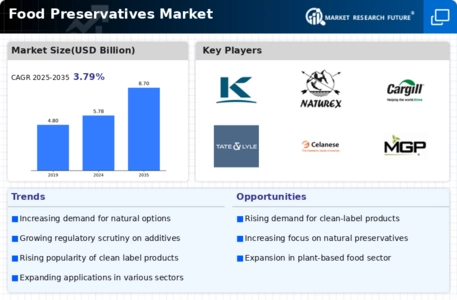Rising Awareness of Food Safety
The Food Preservatives Market is significantly influenced by the growing awareness of food safety among consumers. As incidents of foodborne illnesses continue to garner attention, consumers are increasingly vigilant about the safety and quality of the food they consume. This heightened awareness drives demand for preservatives that ensure food safety and extend shelf life. Market data indicates that the food safety segment is projected to grow at a rate of 5% annually, reflecting the increasing consumer focus on health and wellness. Consequently, manufacturers are compelled to prioritize the use of effective preservatives that comply with safety regulations and standards. This trend not only enhances consumer trust but also propels the Food Preservatives Market forward, as companies strive to meet the stringent demands of safety-conscious consumers.
Regulatory Compliance and Standards
The Food Preservatives Market is significantly shaped by the need for regulatory compliance and adherence to food safety standards. Governments and regulatory bodies worldwide impose stringent regulations on food additives, including preservatives, to ensure consumer safety. This regulatory landscape compels manufacturers to invest in research and development to create preservatives that meet these standards. Market data indicates that compliance costs can account for up to 15% of total production costs, influencing pricing strategies and product formulations. As a result, companies in the Food Preservatives Market must navigate these regulations carefully while striving to innovate. This dynamic creates both challenges and opportunities, as manufacturers seek to develop preservatives that not only comply with regulations but also resonate with consumer preferences for safety and quality.
Increasing Demand for Processed Foods
The Food Preservatives Market experiences a notable surge in demand for processed foods, driven by changing consumer lifestyles and preferences. As urbanization continues to rise, consumers increasingly seek convenience, leading to a higher consumption of ready-to-eat meals and snacks. This trend is reflected in market data, which indicates that the processed food sector is projected to grow at a compound annual growth rate of approximately 4.5% over the next five years. Consequently, the need for effective food preservatives becomes paramount to ensure product longevity and safety. Manufacturers are thus compelled to innovate and incorporate preservatives that not only extend shelf life but also meet consumer expectations for quality and safety. This dynamic creates a robust environment for the Food Preservatives Market, as companies strive to balance convenience with health-conscious choices.
Expansion of the Food and Beverage Sector
The Food Preservatives Market is poised for growth due to the expansion of the food and beverage sector. As the global population continues to rise, the demand for food products is expected to increase, leading to a corresponding rise in the need for preservatives. Market data suggests that the food and beverage industry is anticipated to grow at a compound annual growth rate of 3.8% over the next five years. This growth is driven by factors such as increased disposable income and changing dietary preferences. As manufacturers seek to meet this rising demand, the use of preservatives becomes essential to ensure product quality and longevity. Thus, the Food Preservatives Market stands to benefit from the overall expansion of the food and beverage sector, as companies invest in innovative preservation solutions to cater to a diverse consumer base.
Technological Advancements in Preservation Techniques
Technological innovations play a crucial role in shaping the Food Preservatives Market. Advances in preservation techniques, such as high-pressure processing and modified atmosphere packaging, enhance the efficacy of preservatives while maintaining food quality. These technologies allow for the reduction of chemical preservatives, aligning with consumer preferences for cleaner labels. Market data suggests that the adoption of such technologies is expected to increase by 20% in the next few years, as manufacturers seek to improve product safety and extend shelf life. Furthermore, the integration of smart packaging solutions, which can indicate freshness and spoilage, is likely to revolutionize the industry. As a result, the Food Preservatives Market is positioned to benefit from these advancements, as they not only improve preservation methods but also cater to the evolving demands of health-conscious consumers.

















Leave a Comment